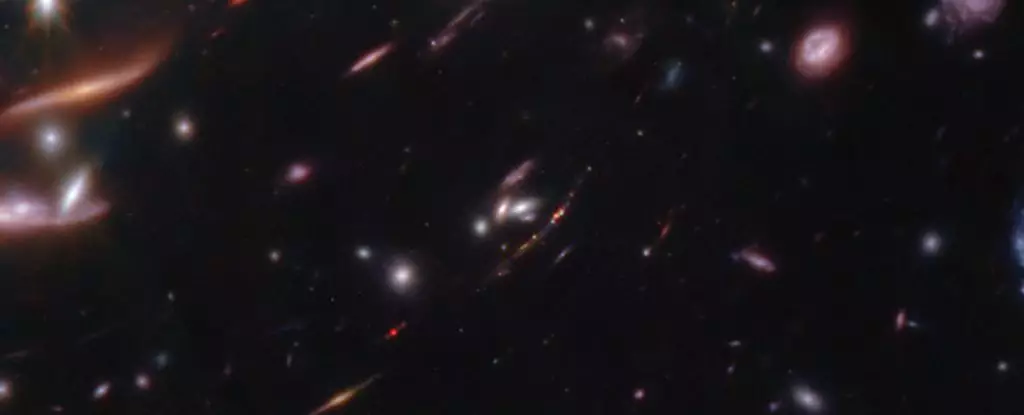The cosmos has always been a subject of intrigue and wonder, particularly regarding its formative years. A recently studied galaxy, dubbed “Firefly Sparkle,” offers a captivating glimpse into the Universe’s early days, around 600 million years post-Big Bang. This unique galaxy is bursting with stellar formation and has revealed itself through the marvels of advanced telescopic technology and gravitational lensing, techniques that empower astronomers to explore the otherwise elusive parts of the cosmos.
The Firefly Sparkle galaxy has enchanted astronomers not just because of its luminosity but due to its historical significance in understanding the evolution of galaxies like our own Milky Way. The galaxy’s light has traversed 13.2 billion years to reach us, providing an extraordinary view that has unveiled ten distinct star clusters. This image challenges previous assumptions about the formation of galaxies at such an early epoch. Lamiya Mowla, an astrophysicist at Wellesley College, is astonished by the intricate structures present in Firefly Sparkle, saying, “There is so much going on inside this tiny galaxy, including so many different phases of star formation.”
This period, colloquially referred to as the Cosmic Dawn, represents a critical time when matter in the Universe began to coalesce, forming stars, galaxies, and the building blocks of everything we see around us today. However, viewing the Cosmic Dawn remains a daunting task for astronomers due to the vast distances involved and the faintness of the objects within this epoch. Nevertheless, the remarkable capabilities of the James Webb Space Telescope (JWST) and gravitational lensing have made this possible.
Gravitational lensing plays a pivotal role in our understanding of distant celestial objects. The phenomenon occurs when massive bodies, such as galaxy clusters, warp the fabric of space-time due to their substantial gravitational fields. This distortion enables light from far-off galaxies, like Firefly Sparkle, to bend around these massive objects, effectively magnifying and revealing details otherwise hidden to our telescopes.
Through this optical manipulation, astronomers can rearrange the warping effects of light into a coherent image that brings distant galaxies into sharper focus. Firefly Sparkle, located behind a massive galaxy cluster, has benefitted from this phenomenon, allowing researchers to decode the intricacies of its star formation processes and mass, which surprisingly echoes that of the Milky Way during its formative stage.
The detailed observations from the JWST highlight that Firefly Sparkle, with a mass comparable to an infant Milky Way, exhibits an array of star clusters, each at different stages in their lifecycle. The presence of vibrant colors indicates varied evolutionary paths, with each cluster momentarily capturing a snapshot of the Universal timeline. These clusters together account for about half of Firefly Sparkle’s total mass, emphasizing not only the richness of its star-forming capabilities but also offering insights into how primordial galaxies grew complex frameworks.
The discoveries surrounding Firefly Sparkle underscore that its neighboring galaxies are also essential to understanding its formation. Two nearby galaxies with distances of 6,500 light-years and 42,000 light-years hint at gravitational interactions – implying that Firefly Sparkle may be experiencing a formative dance with its cosmic peers. As stated by Yoshihisa Asada from Kyoto University, the interactions and mergers with smaller galaxies are fundamental in the lifecycle of larger galaxies, including our own.
The exposure of Firefly Sparkle offers far-reaching implications in our understanding of galactic formation and evolution. Every new piece discovered can illuminate aspects of our own galaxy’s history as well as inform theories regarding cosmic evolution. The CWST’s capacity to explore the early Universe through gravitational lensing implies that similar discoveries will become more commonplace. Maruša Bradač from the University of Ljubljana notes, “This is just the first of many such galaxies JWST will discover.” Such advancements promise to enrich our understanding of galactic evolution.
The Firefly Sparkle galaxy serves as a monumental key to unlocking galactic mysteries and epitomizes the profound strides made in astrophysical research. With each revelation, astronomers draw closer to piecing together the intricate puzzle of our Universe’s early stages, shaping how we perceive the cosmos and our place within it.

